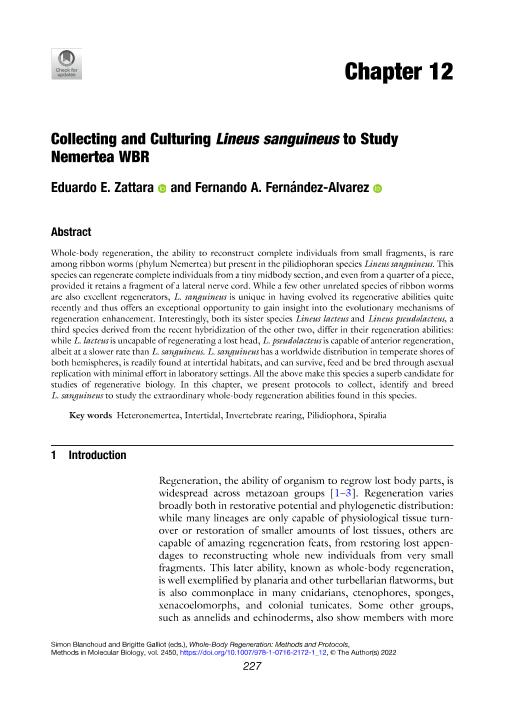Mostrar el registro sencillo del ítem
dc.contributor.author
Zattara, Eduardo Enrique

dc.contributor.author
Fernández Álvarez, Fernando Ángel

dc.contributor.other
Blanchoud, Simon
dc.contributor.other
Galliot, Brigitte
dc.date.available
2023-07-19T12:11:02Z
dc.date.issued
2022
dc.identifier.citation
Zattara, Eduardo Enrique; Fernández Álvarez, Fernando Ángel; Collecting and Culturing Lineus sanguineus to Study Nemertea WBR; Humana Press; 2022; 227-243
dc.identifier.isbn
978-1-0716-2171-4
dc.identifier.issn
1064-3745
dc.identifier.uri
http://hdl.handle.net/11336/204401
dc.description.abstract
Whole-body regeneration, the ability to reconstruct complete individuals from small fragments, is rare among ribbon worms (phylum Nemertea) but present in the pilidiophoran species Lineus sanguineus. This species can regenerate complete individuals from a tiny midbody section, and even from a quarter of a piece, provided it retains a fragment of a lateral nerve cord. While a few other unrelated species of ribbon worms are also excellent regenerators, L. sanguineus is unique in having evolved its regenerative abilities quite recently and thus offers an exceptional opportunity to gain insight into the evolutionary mechanisms of regeneration enhancement. Interestingly, both its sister species Lineus lacteus and Lineus pseudolacteus, a third species derived from the recent hybridization of the other two, differ in their regeneration abilities: while L. lacteus is uncapable of regenerating a lost head, L. pseudolacteus is capable of anterior regeneration, albeit at a slower rate than L. sanguineus. L. sanguineus has a worldwide distribution in temperate shores of both hemispheres, is readily found at intertidal habitats, and can survive, feed and be bred through asexual replication with minimal effort in laboratory settings. All the above make this species a superb candidate for studies of regenerative biology. In this chapter, we present protocols to collect, identify and breed L. sanguineus to study the extraordinary whole-body regeneration abilities found in this species.
dc.format
application/pdf
dc.language.iso
eng
dc.publisher
Humana Press

dc.rights
info:eu-repo/semantics/openAccess
dc.rights.uri
https://creativecommons.org/licenses/by/2.5/ar/
dc.subject
Heteronemertea
dc.subject
Intertidal
dc.subject
Invertebrate rearing
dc.subject
Pilidiophora
dc.subject
Spiralia
dc.subject.classification
Biología del Desarrollo

dc.subject.classification
Ciencias Biológicas

dc.subject.classification
CIENCIAS NATURALES Y EXACTAS

dc.subject.classification
Biología Marina, Limnología

dc.subject.classification
Ciencias Biológicas

dc.subject.classification
CIENCIAS NATURALES Y EXACTAS

dc.title
Collecting and Culturing Lineus sanguineus to Study Nemertea WBR
dc.type
info:eu-repo/semantics/publishedVersion
dc.type
info:eu-repo/semantics/bookPart
dc.type
info:ar-repo/semantics/parte de libro
dc.date.updated
2023-06-29T10:21:33Z
dc.identifier.eissn
1940-6029
dc.journal.pagination
227-243
dc.journal.pais
Estados Unidos

dc.journal.ciudad
Nueva York
dc.description.fil
Fil: Zattara, Eduardo Enrique. Consejo Nacional de Investigaciones Científicas y Técnicas. Centro Científico Tecnológico Conicet - Patagonia Norte. Instituto de Investigaciones en Biodiversidad y Medioambiente. Universidad Nacional del Comahue. Centro Regional Universidad Bariloche. Instituto de Investigaciones en Biodiversidad y Medioambiente; Argentina. National Museum Of Natural History. Departamento de Zoología. Area de Invertebrados; Estados Unidos
dc.description.fil
Fil: Fernández Álvarez, Fernando Ángel. Consejo Superior de Investigaciones Científicas. Instituto de Ciencias del Mar; España
dc.relation.alternativeid
info:eu-repo/semantics/altIdentifier/url/https://link.springer.com/protocol/10.1007/978-1-0716-2172-1_12
dc.relation.alternativeid
info:eu-repo/semantics/altIdentifier/doi/https://doi.org/10.1007/978-1-0716-2172-1_12
dc.conicet.paginas
685
dc.source.titulo
Whole-Body Regeneration: Methods and Protocols
Archivos asociados
